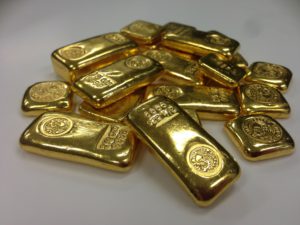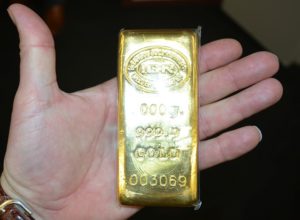Why Invest in Gold and Silver
 Before looking at how to invest in gold, let’s look at the reasons why gold is attractive to hold as an asset. The price of gold and silver are determined by supply and demand. Most of the world’s gold comes from mining, but it can also be uncovered using placer methods or as a by-product from copper mining. China, Australia, and Russia are the largest producers of gold in the world.
Before looking at how to invest in gold, let’s look at the reasons why gold is attractive to hold as an asset. The price of gold and silver are determined by supply and demand. Most of the world’s gold comes from mining, but it can also be uncovered using placer methods or as a by-product from copper mining. China, Australia, and Russia are the largest producers of gold in the world.
When it comes to demand, gold and silver have many uses in jewelry, electronics, industry, aerospace, medicine, and dentistry. They are also used by government and private mints to produce commemorative ingots and coins. Governments and central banks buy and hold huge quantities of gold as a reserve asset. Currently, the U.S. is the largest gold holder, followed by Germany and the International Monetary Fund holding third place.
Private investors buy gold and silver. They treat the purchase of gold and silver as an insurance policy against inflation and uncertainty as well as an investment. Investors may buy gold when they expect a recession, geopolitical uncertainty, inflation or expected depreciation of a currency. Sometimes they hold it as a hedge, or insurance from a stock market decline. Gold and silver do not pay dividends and do not always go up in value. Still they are considered to be prudent assets to hold as part of a well-balanced, diversified financial portfolio.
How to Invest in Gold
 Gold is classified as a commodity. Investing directly in commodities, such as gold or oil, can be more difficult for investors than investing in stocks and bonds. Stocks and bonds are liquid assets easily traded on major exchanges. Commodities tend to be more difficult to invest in due to the complex way in which they trade through the futures and options markets. An investor can’t just go out and buy a barrel of oil.
Gold is classified as a commodity. Investing directly in commodities, such as gold or oil, can be more difficult for investors than investing in stocks and bonds. Stocks and bonds are liquid assets easily traded on major exchanges. Commodities tend to be more difficult to invest in due to the complex way in which they trade through the futures and options markets. An investor can’t just go out and buy a barrel of oil.
However, gold is accessible to the average person who wants to purchase gold bullion (gold in its physical form), from a dealer, a bank, or a mint. More advanced financial instruments are available to make gold easier to invest in without having to buy the physical metal.
Here are the four common methods through which people invest in gold…
Buy Physical Gold
The most direct method for most people to own gold is to buy physical gold. You have probably done this already at one time or another by purchasing gold jewelry. Gold jewelry usually costs more than the value of the gold content. This is because extra work in the form of craftsmanship is required to make it beautiful. You can also own physical gold in the form of bullion or bullion coins. Gold bullion trades very close to the price of gold. This is because bullion doesn’t have any artistic added value, which makes it different from jewelry or numismatic coins. To buy gold bullion you have to pay a premium over the gold price which can be in a range from 3 to 10 percent.
Once you buy gold, you have to store it properly. You could store it at home, but some security issues could arise from this approach. If you decide to purchase and keep it at home, make sure you have a proper safe and take the necessary measures to protect your assets. Otherwise, you will need to arrange for a vault or a bank deposit bow to store it.
Buy Gold Futures
Gold futures contracts provide you with a direct way to invest in gold through the futures markets. Gold futures are standardized, exchange-traded contracts in which the contract buyer agrees to take delivery, from the seller, a specific quantity of gold (eg. 100 troy ounces) at a predetermined price on a future delivery date. Most brokers do not have a delivery option, so the contract is settled in cash when it expires.
Futures contracts trade on organized exchanges. They allow a holder to buy or sell gold at a specified time in the future and at the price specified in the futures contract. You’ll need to open a brokerage account and your broker will walk you through the specific details. In general, here’s how it works…
A gold futures contract at Chicago Mercantile Exchange covers 100 troy ounces. To trade, you need to make a deposit, which is a minimal amount necessary to open a position. Every day your position will be tracked against the market spot price of gold. If the gold price goes in your direction, you’ll make a profit, but if it goes against you, you’ll lose money. Futures contracts are leveraged instruments. You need to maintain an account balance equal to the initial margin. If the price of gold moves in your direction, there are no additional margin requirements. If the price of gold moves against your direction, you will be required to top your account balance up to the initial margin.
Invest in gold ETFs
If you are not a fan of investing in gold futures, you can try gold Exchange Traded Funds (ETFs). Instead of owning a futures contract and paying attention to maintenance margin, you can simply buy shares of an ETF. It is much like buying shares of a mutual fund, but with an exposure to gold. If you’ve never invested in ETFs before, you need to pick a brokerage and open an account. Then, you simply pick your preferred gold ETF.
For example, a popular gold ETF is SPDR Gold Shares (NYSE: GLD). It costs 0.40 percent annually to own it. The ETF follows gold bullion price. For more information about Gold ETFs check out the link – Gold ETF Funds.
Invest in gold mining companies
An investment in gold mining companies offers exposure to gold, but the exposure is sometimes limited. These companies carry operating risks, which can muddle a direct correlation to the gold price. Gold miners are at risk of a default and their shares can trade lower in case of an operating problem with the company regardless of the price of gold.
For more information about Gold Mining Stocks, check out the link Gold Mining Shares May be Good Stocks to Buy Now…
How to Invest in Gold Bullion
 Bullion is a bulk quantity of gold, measured by weight and typically cast as bars. The spot gold price is based on the value of 100 ounce, .999 fine gold bars. Bullion can also be cast or struck into the form of bars, ingots or coins. A bullion coin is one where the gold content determines the value of the coin with no premium for numismatic value, rarity or collectability. Many use the term gold bullion and gold bars interchangeably. The concept of bullion is simple and refers to any precious metals in bulk form, valued by weight.
Bullion is a bulk quantity of gold, measured by weight and typically cast as bars. The spot gold price is based on the value of 100 ounce, .999 fine gold bars. Bullion can also be cast or struck into the form of bars, ingots or coins. A bullion coin is one where the gold content determines the value of the coin with no premium for numismatic value, rarity or collectability. Many use the term gold bullion and gold bars interchangeably. The concept of bullion is simple and refers to any precious metals in bulk form, valued by weight.
How to Invest in Gold Bars
Why should an investor consider gold and silver bars? Because they have lower premiums! Ounce for ounce, bars are less expensive. Coins have a more intricate design and thus greater labor, machining, and minting costs. Coins tend to be smaller and more attractive, but that appeal costs more to manufacture. There’s another advantage to bars: they’re easier to store. A gold or silver bar takes up less space than the same number of ounces of coins.
How to Invest in Gold Coins
If you want to physically hold gold and silver yourself, investment-grade, sovereign bullion coins are the way to go. “Investment grade” simply means refined metal that has high quality, purity, and liquidity. “Sovereign” means they are produced by a government mint. Canadian Maple Leafs and US Golden Eagles are good examples. Sovereign coins come with a guarantee of content and purity, and in most cases, a face value. The face value is mostly symbolic since the gold price is much higher than the value printed on the coin. But it does mean they are still considered legal tender – non-sovereign coins are not.
It is a proven strategy to start with—and build most of your bullion portfolio with—sovereign bullion coins. They are the most liquid coins in the world. Dealers recognize them and buy them with little question. These coins closely track the price of gold, and have the widest customer base versus any other form of bullion. Gold bullion coins trade at a small premium over the actual spot gold price. Many large gold bullion dealers typically will sell a single, American Eagle one troy ounce gold coin at approximately four to five percent over the current spot or melt value. Dealers will also purchase them from customers at about two to five percent less than their selling price.
Investing in Gold vs. Investing in Silver
Silver costs less per ounce to buy than gold. With the same amount of money, you can buy a lot more silver than gold. If you don’t have a lot of extra money and you want to start investing in a precious metal, silver may be a better place to start. Governments and other institutions have traditionally held inventories of silver. Today, most governments no longer hold stockpiles of the metal. In fact, the only countries that warehouse silver are the US, India, and Mexico.
Global demand for silver is growing. Virtually all major government mints have seen record levels of sales, with most already operating at peak production for bullion coins. Surging demand is increasingly evident in China and India. Both of these massive markets have a long history of respect for the wealth preservation afforded by precious metals. Also, both of these populations are growing , so their tremendous appetite is expected to continue to rise.
How to Invest in Silver
 There are a number of ways you can include silver among your assets. Here are four common ways in which people invest in silver…
There are a number of ways you can include silver among your assets. Here are four common ways in which people invest in silver…
Buy Silver Bullion
Gold remains the king of precious metals for millions of investors. But silver is a solid choice for many investors due to its diversity and affordability. One of the greatest assets silver has in its favor is its affordability. However, its diversity might surprise you. You can find silver for sale in a wide range of product types that include coins, bars, rounds, and even statues and medallions.
Perhaps the most popular way to invest in silver, is to simply purchase quantities of the metal outright. This method has the advantage of simplicity. You own the asset outright and can sell it at any time for market price (minus a dealer commission). There are storage, insurance and logistics to consider, but you don’t have to deal with any third parties if you don’t want to. You are exposed to the full volatility of the silver market, but you are in control and you can sell any time you choose.
Buy Silver Futures
The most common way to invest in commodities, futures and options contracts allow you to invest in the movement of the silver market. Your profit here comes not from the market value of silver but from how that value changes.
How Leverage Works – For example, suppose you had $5,000 to invest. If you buy silver bullion outright, you are limited to a total purchase of $5,000 worth. But the futures market works on leverage. You can probably control $100,000 worth of silver futures! That’s because your margin on a $100,000 futures contract will probably be about 5% – i.e. $5,000. If the underlying price goes up 10% you would make $500 from bullion, but $10,000 from leveraged silver futures.
Invest in Silver ETFs
A silver ETF is built to track the market price of silver metal. It is often built around a specific quantity of silver or group of bullion assets. This is generally considered one of the best ways to own and trade silver with high liquidity and without the logistical challenges of owning the physical asset.
ETFs are funds traded on a stock exchange. They are made up of a collection of third party assets. Your value comes from how those underlying assets perform. A silver ETF should closely track the performance of the silver index for the price of silver bullion. Likewise, a silver mining ETF should track and magnify the gain and loss of silver as it rises and falls in price.
Since ETFs trade like stocks, buyers must pay a brokerage commission every time they buy or sell shares. Those commissions can add up quickly, especially if you’re buying more shares each month. ETFs are great for lump-sum investors, but you should consider using a traditional index fund if you’re buying a little bit at a time.
Invest in Silver Mining Companies
One major issue with a direct investment in silver is that there is limited growth potential. An ounce of silver today will be the same ounce of silver 100 years from now. The price can increase, but the amount of silver does not grow. That’s why some invest in silver by owning the stock of silver mining companies. The prices of mining stocks tend to follow the prices of the commodities on which they focus. However, because miners are running businesses that can expand over time, investors can benefit from increasing silver production as well as price appreciation.
Silver stocks and mutual funds
Stocks and mutual funds let you invest in silver mining companies and firms which deal in the production, distribution and use of silver. These stocks generally track the market value of silver but have value beyond pure supply and demand. As a result they can be more reliable and less volatile than pure silver. Just be aware that they are mining companies, so they are subject to potential business-related liabilities. It can take close research to find a pure silver producer. Many one-time silver miners are actively shifting their focus toward gold. There are good silver mining companies to choose from. It just may take a little more work to find them.
Some investors look for silver stocks that pay dividends. A dividend is a sum of money that is paid regularly by a company to a class of its shareholders out of its earnings. Dividends are often issued as cash payments, but can also be issued as additional stock. Even if the price of silver moves sideways, income from dividends can produce a profit in a flat market.
Buy Gold Silver Safely
Most gold and silver is bought in one of two places: a local coin shop or online. Believe it or not, you’ll likely find better pricing online than at a coin shop, even after factoring in shipping costs. That’s because the overhead at brick-and-mortar stores is higher. But that’s just part of the difference.
Local Coin Shop
Local coin shops are a solid option and have definite advantages:
- You can see actual product and examine it first
- Immediate possession is possible after your purchase
- You can negotiate the buy-back premium if you ever need to sell
- There is potentially greater privacy and confidentiality
Even if you decide to buy online, you should still consider checking with a local dealer first. A relationship
with them can be helpful if you need to make a quick sale. If you decide to buy from them, see if
they’ll negotiate on price.
Online Dealers
Buying from an online seller comes with one obvious risk: You have to pay up front, and then trust that the dealer delivers what you purchased. But this isn’t normally an issue with a well-established online dealer—the last thing they want is for word to get around that they rip people off. And if you pay with a credit card you may be able to use your bank’s chargeback policy if necessary. Buying from a reputable online seller should really be no different than ordering something from Amazon.
Bottom Line
Gold and silver offer unique inflationary protection
- Intrinsic value,
- No credit risk
- Cannot be inflated – you can’t just print more of them.
- Genuine “economic insurance” against financial, political or military upheavals.
Stocks To Buy Now
Interested in traditional assets like stocks? Check out Stocks to Buy Now…